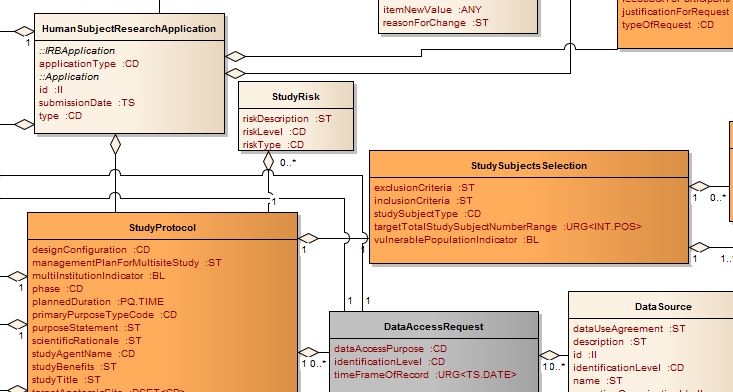
IRB Domain Analysis Model
There are three subfolders in the IRB Domain Analysis Model.
- The first subfolder “Activity Diagrams” contains the IRBApplicationStatus state machine, illustrating the state transition for IRB applications. Clicking the “In Review” status will lead to a sub state machine.
- The second subfolder “BPMN 2.0 Models” contains four behavioral models, representing the dynamic aspect of the IRB domain analysis model. Two of them are business process models, which specify the high-level features of an e-IRB system, with a focus on end-user perspective of the functionality of the application. The other two are collaboration models that demonstrate the interactions between e-IRB systems and other clinical research information systems.
- The third subfolder “Domain Information Model” (a.k.a.Entity-Relationship model) is the core of the IRB DAM. It contains 97 classes and 132 relationships, which represent the static aspect of the IRB domain analysis model. Each class contains attributes and a HL7 abstract data type is defined for each attribute.
Research-Oriented Health Data Representation (ROHDR) Model
Implementation of the IRB entity-relationship model enables syntactic interoperability by specifying the structure of information being exchanged between different systems. However, to make the meaning of the exchanged content understandable to the receiving system, semantic interoperability should be achieved. Therefore every attribute with the HL7 data type CD (ConceptDescriptor) in the IRB entity-relationship model needs to be bound to value sets where each value set consists of one or more coded concepts.
The value sets for dataCategory and dataElementName were developed to define standardized representations of health data categories and specific data elements requested by researchers. To implement these two value sets, we adapted the Common Data Model (CDM) Version 4 from the Observational Medical Outcomes Partnership (OMOP)
We translated the OMOP CDM to a high-level logical data model in UML class diagram with implementation-related attributes removed. In addition, 14 classes were added to the translated diagram based on domain expert consultation. This formed our Research-Oriented Health Data Representation (ROHDR) model.

